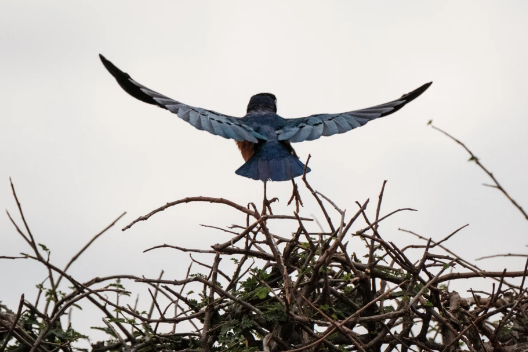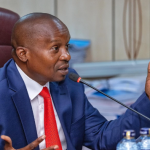In the heart of Samburu County, as the first light of dawn spreads across the horizon, a dedicated group of women and men work diligently, cultivating and harvesting seeds from the resilient grasses they’ve nurtured. The warm morning glow contrasts sharply with the severe droughts that once devastated their livestock.
Just five years ago, the looming threat of drought endangered their entire livelihood. Today, that story has been transformed into one of hope and renewal.
Thanks to their tireless efforts, not only are the rangelands flourishing, but they have also become a source of income through the sale of carbon credits. These credits, which allow holders to emit a certain amount of carbon dioxide or other greenhouse gases, represent a concrete step in the fight against climate change. Each credit permits the release of one ton of carbon.
Antoninah Lemekwi, one of the beneficiaries of the project, reflects on the remarkable change brought about by the Northern Rangelands Trust, a non-governmental organization that has been a beacon of hope.
“We used to hear about carbon credits but had no idea what they meant. The Northern Rangelands Trust showed us that by restoring our rangelands, which had been devastated by prolonged droughts, we could not only grow grasses to sustain our livestock but also generate income through carbon credits,” she explains.
Restoring the Rangelands
Scientific studies suggest that East Africa’s savanna rangelands can absorb between 65 to 70 tons of carbon dioxide annually, emphasizing the importance of these restoration efforts. But how is this progress tracked?
Mohammed Shibia, the carbon credit manager for Northern Rangelands Trust, explains, “We monitor our project area using advanced remote sensing analysis. This technology enables us to track our success year after year. Satellite imagery is used to ensure that carbon credits are only issued for areas where improved grazing practices have been genuinely implemented.”
A key tool in this monitoring process is the Normalized Difference Vegetation Index (NDVI). By analyzing satellite images of the Earth’s surface, NDVI assesses plant health, revealing the delicate balance between grazing and vegetation. Healthy plants reflect light differently than stressed ones, providing valuable data for the project.
“Our model differentiates between the impact of livestock grazing and the effects of climate change on plant productivity,” Shibia explains.
As these groundbreaking efforts progress, the Samburu community leads a transformative journey, not only restoring their land but also redefining their connection with nature—a bond that promises sustainability and economic resilience for generations to come, if not the entire planet.
“Our homeland was once barren. There was no grass, trees had been cut down, and grazing was disorderly,” says Peter Lesepe, a passionate community member. “But since we began this journey, we’ve planted grasses, and our trees are flourishing. There is now order in our land,” he adds.
The core aim of the project is to ensure that communities and individuals who work diligently to enhance their land’s carbon storage capacity are recognized and rewarded for their efforts. By purchasing carbon sequestered in these community rangelands, the initiative not only provides a critical source of income but also strengthens conservation efforts, paving the way for a sustainable future.
The Northern Kenya Rangelands Carbon Project offers a unique opportunity for long-term collaboration, utilizing a forward-financing model that facilitates investments in local priorities like water access, infrastructure, and education. This model ensures that the benefits of environmental stewardship are directly felt by the communities involved.
Carbon Footprint Monitoring Technology in the DRC
In a similar development, the Democratic Republic of Congo (DRC) has signed a landmark agreement with Chinese climate-tech firm Luokung Technology to implement a Digital Measuring, Reporting, and Verification (DMRV) platform for accurate carbon footprint measurement.
This milestone was overseen by Lama Onyangunga, CEO of the Congolese Environment Agency, who witnessed the signing of a Memorandum of Understanding (MOU) between the DRC government and Luokung Technology, with Nairobi-based Shiftings Limited representing Luokung’s interests in Africa.
“We are pleased that the DRC will benefit from this carbon credit initiative. Carbon assets are sovereign assets that will empower the government and its people, reducing dependence on international loans with high interest rates,” said Cyrus Jirongo, CEO of Shiftings Limited.
As this crucial moment unfolds, it highlights the growing recognition of carbon credits as a valuable tool for sustainable development in both Northern Kenya and the Democratic Republic of Congo (DRC). Together, these initiatives lay the foundation for a greener, more prosperous future—one where communities and the environment flourish side by side.
Lama Onyangunga, Chief Executive Officer of the Congolese Environment Agency, emphasized President Felix Tshisekedi’s steadfast commitment to addressing global warming, a pressing issue that intensifies extreme weather, exacerbates food and water shortages, disrupts economies, and threatens human well-being.
“Our President has consistently highlighted the significance of our country as a solution to environmental challenges, given our vast forests,” Onyangunga said. “This partnership with Luokung Technology marks a major milestone in the global fight against climate change. It will not only combat global warming but is also expected to generate 450,000 job opportunities, including 7,500 specialized positions. This is a monumental project for our nation.”
Raymond Wu Ying, representing Luokung in signing the agreement, echoed this view, stressing the vital role of technology in mitigating climate change and preserving the planet.
“Utilizing advanced technology is crucial for safeguarding the environment and ensuring a sustainable future,” he affirmed.
With this agreement, the DRC becomes the second African nation, following Uganda earlier this year, to sign a Memorandum of Understanding with Luokung to measure its carbon footprint.
According to a report by the United Nations Environment Programme (UNEP), the Congo Basin’s peat swamp forests store an astounding 29 billion tons of carbon—equivalent to three years of global greenhouse gas emissions. Additionally, the Basin absorbs approximately 1.5 billion tons of carbon dioxide annually, making it a key player in the global fight against climate change.
As these initiatives continue, they are shaping a more sustainable future, not just for the DRC but for the entire planet.



